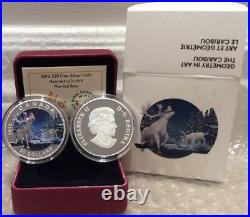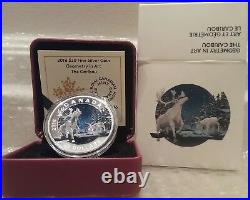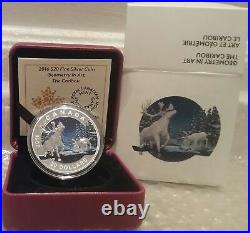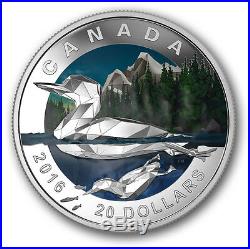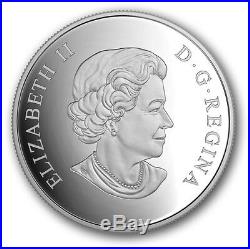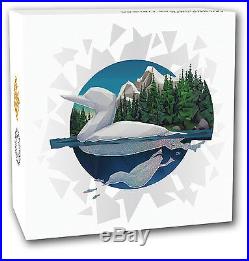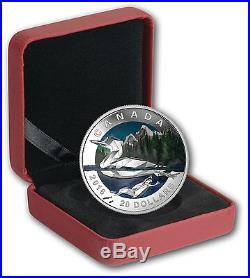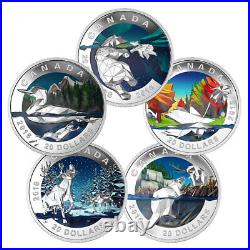
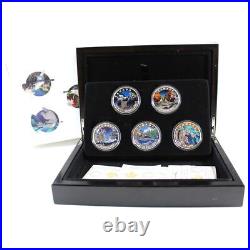
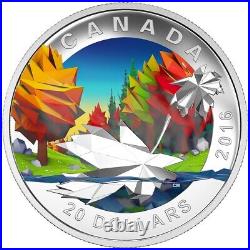
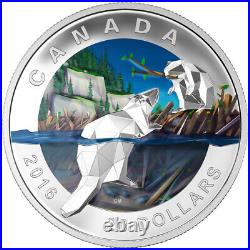
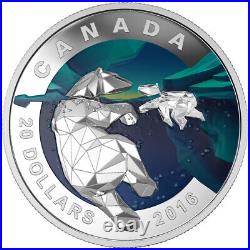
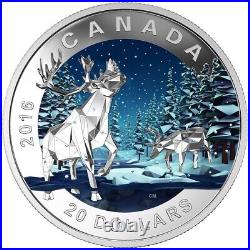
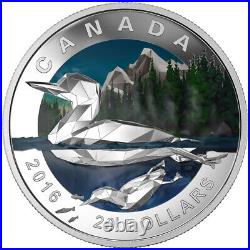
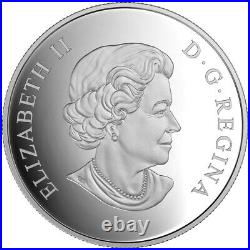
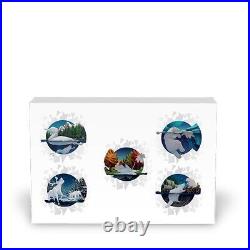
Peoples’ view of the world changed forever when modern art began representing objects with simple lines, shapes, patterns and dimension. Science and art were merged forever, because, at its heart, modern art is all about geometry. This approach fuelled modern technology by providing a mathematical basis for computer-generated imagery (CGI). Polygons could be used to create incredibly lifelike objects, but when Canada’s gaming industry tried to adopt the same technique, a problem emerged: realism requires far too many polygons to support the data-intensive, real-time processing that’s needed during a video game. The solution: low poly, a new visual style that delivered smooth gameplay by using fewer polygons. Today, low poly would be considered unsophisticated and crude, but in the 1990s, it was revolutionary and propelled Canada’s gaming industry forward. This breakthrough series portrays some of Canada’s greatest icons using geometric shapes, and honours low poly as an art form in its own right. The reverse design by Canadian artist Calder Moore features a stylized portrait of two common loons in a pristine, natural setting that speaks of the majesty of Canada’s wilderness! Geometry, technology and art intersect as the entirety of the image is presented in a low poly art style, bringing together multiple polygon shapes in this depiction of an adult loon and its offspring. Each polygon is made distinct from the other through extraordinary sculpting, cutting-edge technology and advanced finishing techniques, while the application of bold colour adds vibrancy and alters our perception of dimension and light. The careful selection of each colour gives the cloudless summer sky its dazzling cerulean tone, making it the perfect backdrop for the towering white and grey peaks of the Rocky Mountains-all beautifully recreated using the hard lines and edges that are characteristic of low poly art. In the foreground, the adult loon is a picture of grace and elegance as it calmly floats on the surface of a blue lake, surrounded by the tranquility of an evergreen forest that is rich with detail and colour. Underwater, the young loon demonstrates the species’ remarkable diving abilities as it uses its webbed feet to propel it forward like a torpedo, its beak quickly closing in on the small fish that will provide it with a well-earned aquatic feast. The reverse design by Canadian artist Calder Moore features an artistic representation of a Canadian forest in autumn, which provides a natural setting for Canada’s most famous emblem: the maple leaf. Geometry, technology and art intersect as the entirety of the image is presented in a low poly art style, with multiple polygon shapes coming together to form the mix of coniferous and deciduous trees on both sides of the river. A rich colour gradient in the background recreates the fading sunset as it casts a golden glow on the fall foliage, while the use of rich colour variants throughout the landscape alters our perception of shadow and light. The eye is naturally drawn to the two engraved maple leaves in the foreground, where extraordinary sculpting, cutting-edge technology and advanced finishing techniques showcase the individual polygons within each form. The geometric lines and corners lend themselves beautifully to recreating the maple leaf’s stem and serrated edges, as a gentle breeze brings both leaves tumbling onto the water’s surface to float above the rocky riverbed. The reverse design by Canadian artist Calder Moore features a stylized portrait of two beavers presented in an eye-catching low poly art style. Extraordinary sculpting, cutting-edge technology and advanced finishing techniques allow each polygon to appear distinct from the other throughout the design. The geometric lines and sharp corners recreate the branches used by the beavers as building material for their dam; yet these same lines are somewhat softened by the colour variation between each polygon, playfully altering our perception of shadow, light and dimension and conveying the rounded shape of each beaver. The half-submerged perspective allows an underwater glimpse of the dam rising up from the mud at the bottom of the pond, while the deep blue sky above adds vibrancy to the green conifers along the rocky cliffs in the background. The reverse design by Canadian artist Calder Moore features a stylized portrait of the “King of the Arctic” and beloved representative of Canada’s North, the mighty polar bear (Ursus maritimus). Geometry, technology and art intersect as the entirety of the image is presented in a low poly art style; multiple polygon shapes come together to form a mother bear (left) and her cub (right), with each shape made distinct from the other through extraordinary sculpting, cutting-edge technology and advanced finishing techniques. Together, they form a touching scene of this iconic species as a mother bear introduces her cub to Canada’s Arctic waters; gracefully swimming out, the mother turns to face her young as he gingerly attempts his first few strokes. The hard edges that are characteristic of this style lend themselves beautifully to recreating the Arctic ice above and below the water’s surface; yet, it is the application of rich, vibrant colours that brings a dynamic quality to the overall design, infusing it with depth and dimension through different shades of blues and whites which create a playful perception of shadow and light. A highly artistic interpretation of a pair of Canada’s beloved Caribou. A powerful male boldly approaches the viewer while his timid companion assesses the water nearby. Both images exceed over the coin’s borders and appear to be taking over the coin. Lines, shapes, patterns and dimension: these fundamental concepts are at the heart of geometry, art and design, forming an indisputable common bond between mathematical and artistic realms. As digital artists seek to recreate the physical world through dimensional images, modelling techniques based on geometric shapes have given way to a new visual style: low poly art. This eye-catching five-coin series utilizes this art style to present a contemporary and highly artistic interpretation of Canada’s most famous icons. A conversation-starter for anyone with an interest in art and dimensional modelling techniques, particularly those used in Canada’s thriving video game development industry. RCM (Royal Canadian Mint). 159.15g (5.115 troy ounces). Deluxe Presentation Box, Colored Outer Sleeve, Mint Capsules, COA. TERMS OF SERVICE AND CONDITIONS. Default carriers include Canada Post, Purolator and UPS, amongst others. If there is a specific carrier you prefer, please contact me for a quote. If you wish to add signature, contact me and I will add at your cost. Default carriers include UPS and DHL amongst others. Please contact me for alternative arrangements. Please be aware of your local regulations prior to ordering. I’m here to answer any questions you might have. Your feedback is appreciated! This item is in the category “Coins & Paper Money\Coins: Canada\Commemorative”. The seller is “orioncoins” and is located in this country: CA. This item can be shipped worldwide.
- Country/Region of Manufacture: Canada
- Certification: Uncertified
- Circulated/Uncirculated: Uncirculated

